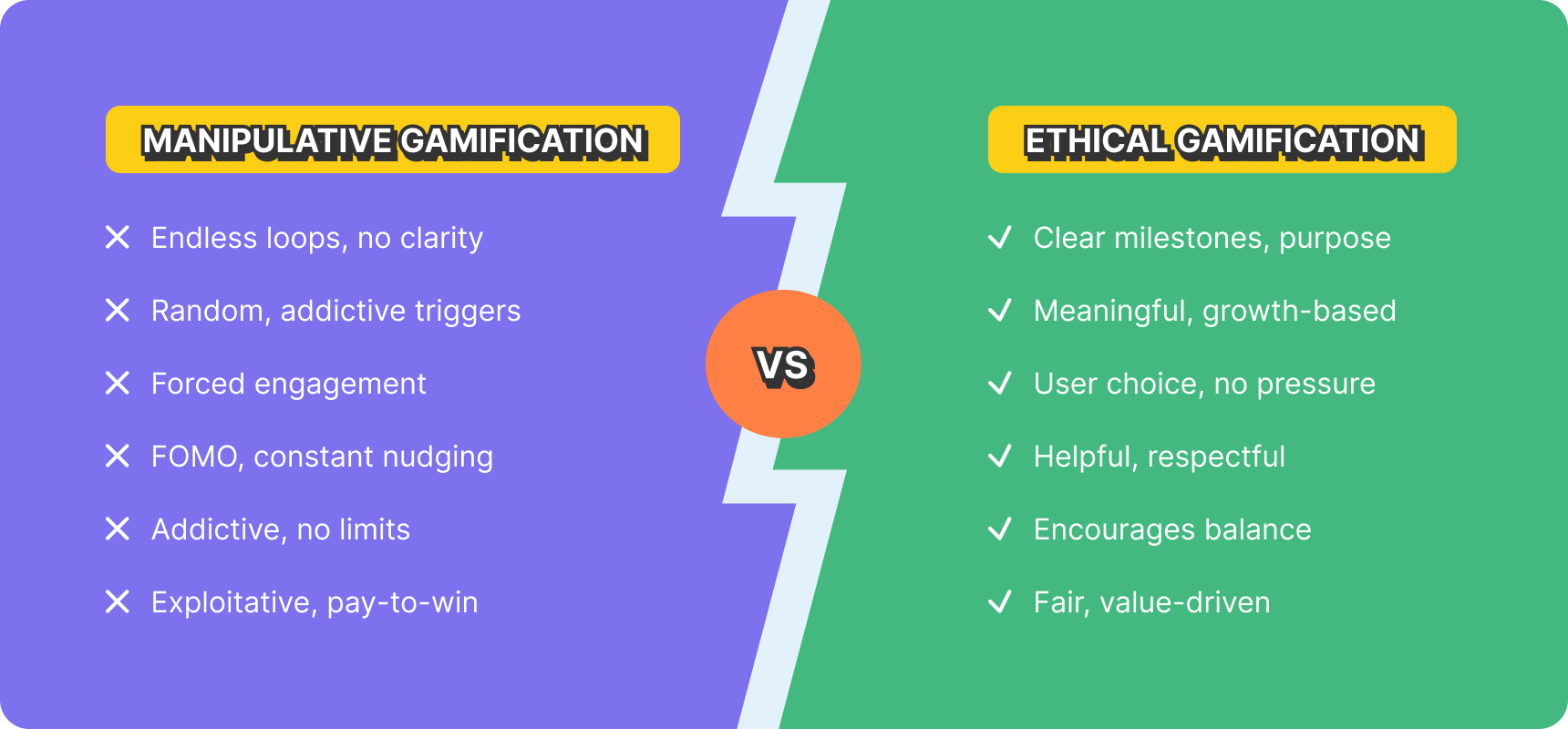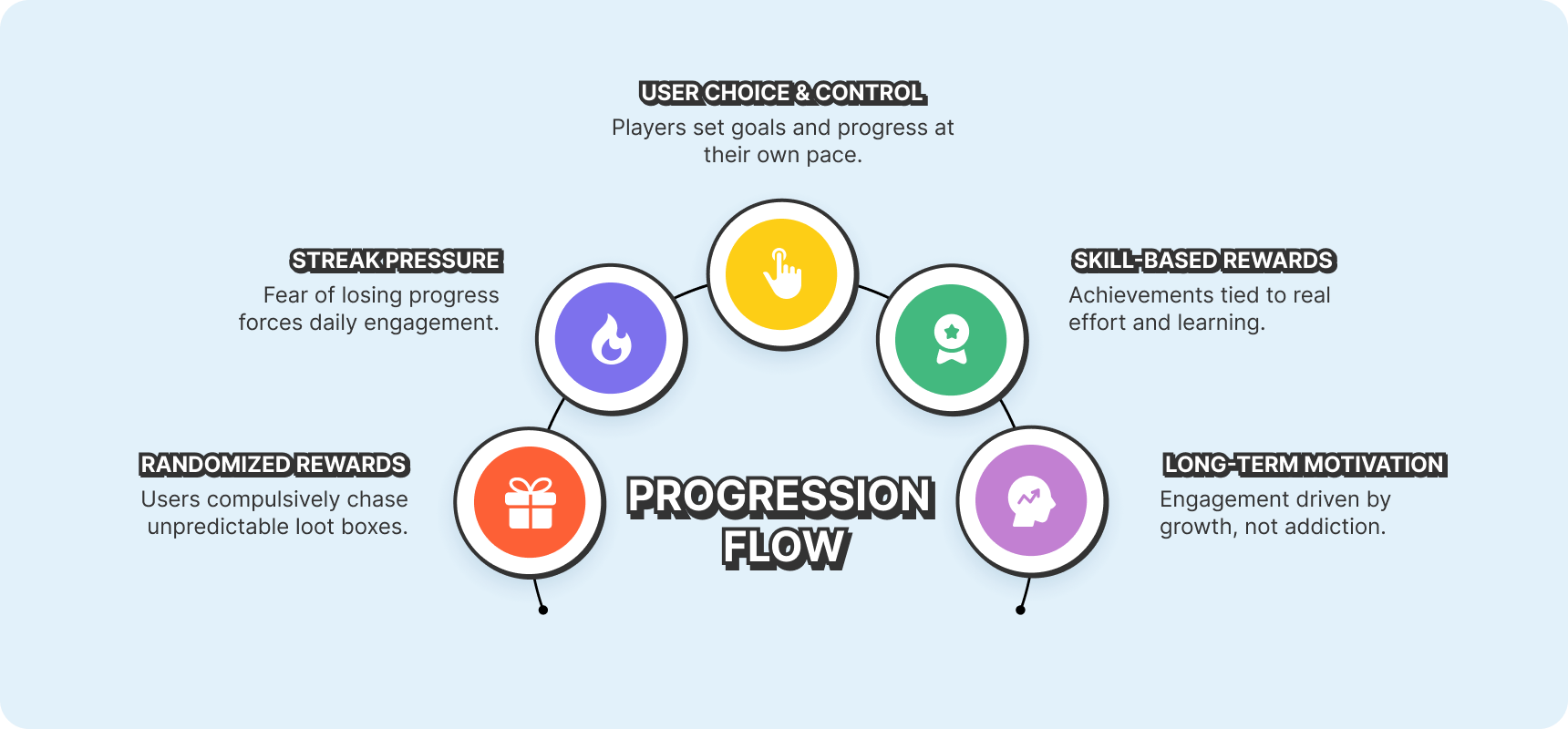







The Dark Side of Gamification (And How to Use Its Secrets for Good)

Part 1: The Dark Side of Gamification (How Manipulative Engagement Works)
The digital landscape is designed to capture and hold our attention. Whether it's the endless scroll of Instagram, the addictive loop of TikTok, or the allure of loot boxes, we've all experienced the phenomenon of losing hours to seemingly harmless online activities. You might find yourself mindlessly refreshing Instagram, suddenly an expert on competitive ferret grooming, a topic you never cared about before. Or perhaps you've watched "just one more" TikTok, only to realize your boss is calling because you were supposed to be on that Zoom meeting 20 minutes ago. You might have even seen a teenager burn through their savings on loot boxes, convinced they're thisclose to unlocking the legendary "Sparkle Pony" skin, or someone swear they'd finally quit online poker get sucked back in by a "VIP Only - Double Deposit Bonus" email at 3 AM.
These experiences are not accidental. They are the result of deliberate design choices, a calculated, psychological assault on our free time and willpower. This isn't some grand conspiracy, but rather a pattern of exploitation by tech companies, online casinos, and even well-meaning membership site owners.
Big tech, online casinos, and mobile games exploit psychological loopholes to keep users engaged. Their primary motivation isn't user experience or helping individuals achieve their goals; it's profit. Unfortunately, membership site owners often replicate these manipulative tactics, unaware of why they fail to produce the desired results. They implement badges, convoluted leaderboard systems, and incessant push notifications, only to find their communities превращаются into digital ghost towns, where initial enthusiasm quickly fades.
Before we explore how to harness these engagement tactics ethically, it's crucial to expose the dark side of gamification.

The Gambling Loophole: Random Rewards and the Illusion of Control
The rise of Counter-Strike skin gambling exemplifies this dark side. This multi-million-dollar industry allows players to purchase in-game skins for real money and use them as virtual casino chips. These platforms often target underage players, operate in legal gray areas, and leverage randomness to fuel addictive behaviors.
The core mechanism at play is variable rewards, a psychological technique akin to dangling a shiny object in front of a magpie.
- A player spends $2.50 to open a loot box.
- The process mimics a slot machine, creating anticipation.
- The player might win a valuable $10 skin or receive a worthless item.
- Regardless of the outcome, the player feels close to winning, triggering a desire to continue.
This taps into the psychology of near-misses, a principle that drives the profitability of slot machines. Even in losses, the sensation of almost winning entices individuals to keep playing, investing more money in pursuit of a win.
How Some Membership Sites Misapply This:
Many membership sites misapply this principle by:
- Awarding users random and meaningless badges, such as "Congrats! You logged in on a Tuesday!"
- Creating leaderboards that only reward the top 1%, thereby demotivating the majority of users.
- Offering unpredictable rewards unrelated to genuine progress, such as "Congratulations on being a member for two weeks! You won...absolutely nothing!"
These tactics amount to digital bribery and insult the intelligence of members.
The Coffeezilla video, The $1,000,000,000 CSGO Skin Gambling Empire, really opened my eyes to this. These are the same people plastering flyers up around schools and malls, talking about a great opportunity.

The Social Media Trap: Infinite Scrolling and Dopamine Loops
The addictive nature of social media platforms like TikTok and Instagram is well-documented. Users often find themselves endlessly scrolling, losing track of time. For instance, someone might open TikTok to find an avocado toast recipe and end up watching a video of a squirrel waterskiing.
Several design elements contribute to this phenomenon:
- Infinite feeds: A continuous stream of content ensures there is always something new to consume.
- Intermittent rewards: The unpredictable nature of the next post, which might be captivating, keeps users engaged.
- Social validation: Likes and comments provide small dopamine hits, reinforcing the behavior of posting and checking for responses.
Social media apps are engineered to hijack attention, so effectively that individuals seek out detox programs to break free from their grasp.
How Some Membership Sites Misapply This:
Some membership sites attempt to replicate this engagement by:
- Bombarding users with notifications to encourage logins, with messages like, "Hey! Log in! We missed you! No seriously, log in! Please?"
- Providing endless, unfocused content instead of clear, structured learning paths, akin to giving someone a pile of ingredients and expecting them to bake a cake. This is a common mistake. Membership sites often throw a multitude of resources at their members—videos, articles, forum discussions, downloadables—without providing a clear roadmap for how to navigate and utilize them effectively. Members are left wondering, "What do I do now?" and become overwhelmed, leading to disengagement. When auditing such sites, it's common to find a wealth of content but a lack of direction, leaving users feeling lost and frustrated.
- Creating forums that lack genuine interaction, substituting real connection with reaction emojis. This is a pitfall many membership sites fall into, especially in the early stages. A forum with only a handful of members can feel like a ghost town, making it difficult to foster a sense of community. Relying solely on reaction emojis to stimulate engagement can further exacerbate this issue, as it replaces meaningful interaction with superficial gestures.
The Mobile Game Addiction: Streaks, Scarcity, and Pay-to-Win Tactics
Mobile games often employ tactics that exploit psychological vulnerabilities. Streak-based engagement, for example, pressures users to log in daily out of fear of losing progress.
Another common tactic is artificial scarcity, where companies create the illusion of "limited" deals that are, in fact, perpetually available.
- “Special event! 24 HOURS ONLY!” (FOMO kicks in.) "OMG, this deal is ending SO SOON! Even though it'll probably be back next week. But just in case, I need to buy it NOW!"
- “Out of lives? Pay $5 to keep playing!” (Sunk cost fallacy.) "I've already sunk hours into this game! I can't stop now! I HAVE to buy more lives! Even though it's basically a digital crack addiction."
- “Your progress resets if you stop now!” (Loss aversion.) "All my progress is gone if I don't keep playing?!!? OMG, I can't possibly quit. "
How Some Membership Sites Misapply This:
Membership sites may also make errors such as:
- Punishing users for missing a day instead of celebrating long-term progress, with messages like, "You missed a day! Lose 100 points and your gold status!!!!"
- Overloading members with time-sensitive challenges, inducing stress rather than motivation.
- Designing gamification elements that feel like a trick rather than a reward.

Part 2: Flipping the script (How to use these strategies ethically)
Having examined the dark side of gamification, we now turn to the question of how to ethically leverage these powerful engagement strategies to genuinely benefit our members.
Random Rewards → Surprise and Delight
Instead of employing gambling-style randomness, we can use intentional surprise rewards to reinforce progress.
Example:
- Unlock bonus content or secret perks after a member completes a lesson. Instead of a generic, "Congrats! You finished Chapter 1!" offer a specific reward: "You unlocked a bonus interview with the author, where she reveals the inspiration behind the story!"
- Send a surprise “thank you” reward to long-term subscribers. For instance: “Happy Anniversary! Here’s a free upgrade to our premium plan for a month!” (Ensure this is sustainable.)
- Create mystery achievements for exceptional performance. A travel photography course could feature a hidden achievement called "The Ansel Adams Award" for outstanding photo submissions, with a detailed description explaining the criteria for earning it.
Key difference: Ensure rewards feel earned and are not arbitrary.
FOMO and Scarcity → Time-Limited Challenges
Rather than manipulating users with false scarcity, use healthy urgency to encourage action.
Example:
- Implement a 30-day challenge aligned with a specific goal. A cooking membership could offer "The 30-Day Knife Skills Challenge," emphasizing the practical benefits of improved technique.
- Organize seasonal events that recognize participation, not just winning. A travel photo course could host a winter photo contest, challenging members to capture images in snowy conditions.
- Offer limited-time content drops that feel like special events, not manipulative gimmicks. For example: "This week, we're releasing a behind-the-scenes video with the software engineer who built the course! Watch the video this week only."
Key difference: Use scarcity to inspire action, not stress.
Infinite Scrolling → Infinite Progression
Instead of an endless feed of distraction, design an endless journey of mastery.
Example:
- Develop progressive learning paths where completing one module unlocks the next. Structure the course like an epic road trip, incorporating a progress bar and a theme-appropriate user interface.
- Implement a skill tree that allows members to choose their learning paths based on their interests. An art course could offer specializations in painting, photography, or sculpture, branching out from foundational skills like color theory and composition.
- Utilize visual progress trackers to make learning tangible. A language course could display a map of the target country, with pins dropped on the map as lessons are completed.
Key difference: Ensure progression is meaningful and not a mere tactic to keep users "hooked."
Streaks and Sunk Costs → Habit Formation and Mastery
Instead of using forced daily logins and streaks, cultivate genuine motivation.
Example:
- Celebrate milestones like 100 days of learning without punishing users for missed days. For example: "Congratulations on your 100-day streak! Your commitment to learning this skill is commendable. Here's a badge to celebrate your achievement."
- Employ habit trackers that promote consistency without inducing stress. A cooking course could challenge members to cook one new recipe per week or explore a different cuisine.
- Reward long-term engagement, not just daily check-ins. A photography membership could award bonus points to members who consistently contribute high-quality posts and provide valuable feedback over time.
Key difference: Help users build real habits rather than relying on guilt-driven streaks.
Addictive Dopamine Hits → Meaningful Motivation
Replace shallow rewards with opportunities for members to experience a deep sense of progress.
Example:
- Incorporate milestone reflections to highlight achievements. Send monthly emails summarizing accomplishments, such as, "This month, you watched 10 hours of lessons, created 3 new pieces of art, and provided helpful feedback to 5 other members!"
- Prioritize peer recognition (such as kudos from mentors or fellow members) over points. Ensure the forums are user-friendly and facilitate the process of giving and receiving feedback.
- Showcase the real-world impact of members' learning through testimonials and transformation stories. Feature members who have secured new jobs or achieved significant milestones as a result of their participation.
Key difference: Focus on intrinsic motivation rather than extrinsic addiction.

Part 3: Building a membership site people can't quit (for the right reason)
When gamification is implemented ethically, members are motivated to return because they want to, not because they feel obligated. This is the ultimate goal of successful membership sites.
While the previous sections focused on individual user motivation, experts argue that the most powerful ethical engagement tool is community-driven progress. Here's how to harness the power of social motivation:
- Peer-driven rewards: Encourage members to recognize and reward each other's contributions. This could involve features like "kudos" buttons, member spotlights, or opportunities to give public testimonials. Recognition from real humans is far more motivating than points or badges.
- Shared goals & challenges: Design group challenges that require members to collaborate and support each other. This fosters a sense of camaraderie and shared purpose, boosting motivation naturally.
- Mentorship & status within a community: Create a system where members can progress through community ranks based on their contributions, expertise, and helpfulness. This provides a natural progression path and encourages members to invest in the community's success.
By incorporating these elements, you can create an engagement model that feels richer and more rewarding than one based solely on game mechanics.
Key principles for ethical gamification:
- Make progress feel rewarding, not manipulative. Emphasize the journey and the destination.
- Use engagement loops that reinforce growth, not guilt. Cultivate a positive cycle where members feel good about their progress, motivating them to continue learning.
- Prioritize building belonging over simply keeping people busy. Foster a thriving community where members support each other, exchange ideas, and feel connected to a larger purpose.

The Bottom Line: Gamification, like any tool, can be used for good or ill. Its ethical application is what distinguishes transformative experiences from manipulative ones.
Instead of creating dopamine traps, strive to design experiences that inspire genuine transformation.
Want your WordPress-powered membership site to become a community that members are excited to be a part of? Embrace ethical engagement and leave manipulative tactics behind.
Here are your next steps:
- Audit your current gamification strategy:
- Identify the core engagement mechanics you're currently using (points, badges, leaderboards, challenges, etc.).
- For each mechanic, ask yourself: "What is the intended outcome? What user behavior am I trying to encourage?"
- Then, critically evaluate: "Could this mechanic be perceived as manipulative? Does it rely on fear, obligation, or a sense of being tricked?"
- Look for any instances where users might feel pressured to participate, even if they're not genuinely interested or benefiting from the experience.
- Document your findings.
- Choose one ethical strategy to implement this week:
- Based on your audit, select one area where you can make a positive change.
- For example, if you're using a leaderboard, consider how you could reframe it.
- Instead of "Share your results in our Facebook group!", create a dedicated space on your membership site for members to share their experiences and progress, and offer a small reward for participation.
- Set a specific, measurable, achievable, relevant, and time-bound (SMART) goal for your implementation.
- Share your results:
- Track the impact of your change. Did it lead to increased engagement, more positive feedback, or a greater sense of community?
- Be prepared to iterate on your strategy based on the results. Ethical gamification is an ongoing process of experimentation and refinement.
- Consider sharing your journey and learnings not only in your Facebook group but also in a blog post or case study on your website. This can position you as a leader in ethical gamification and attract like-minded members.Let's work together to build membership sites that are both engaging and ethical, creating a better online experience for everyone!
THAT’S A WRAP! NOW, GO FORTH AND GAMIFY RESPONSIBLY!
Recommended for you



